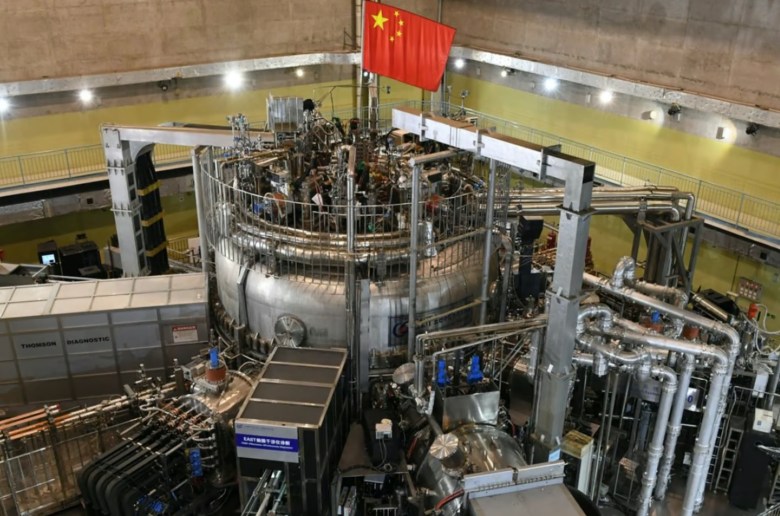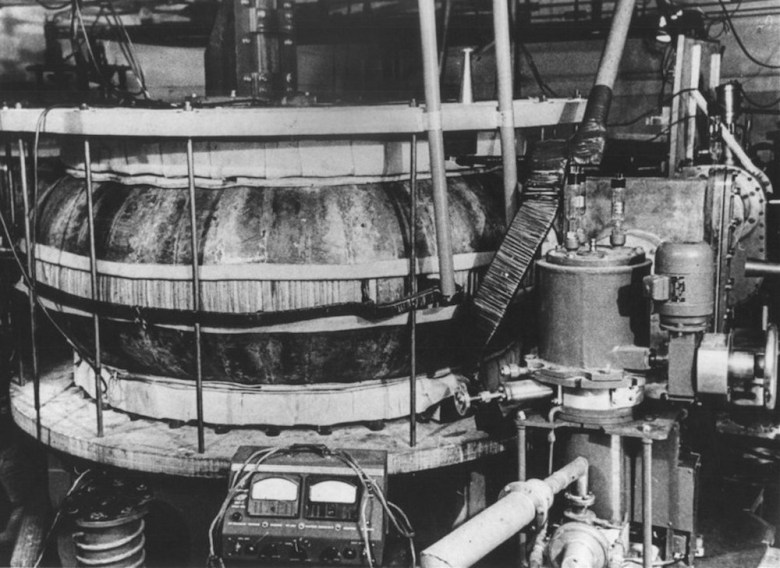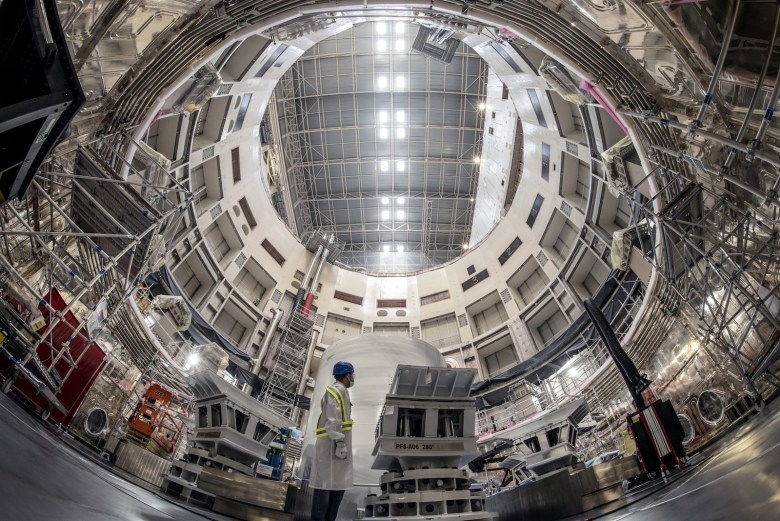onebyone
SENIOR MEMBER

- Joined
- Jul 2, 2014
- Messages
- 7,550
- Reaction score
- -6
- Country
- Location
China’s EAST breakthroughs shorten path to fusion power
China’s Experimental Advanced Superconducting Tokamak achieves yet another fusion milestone with new ‘Super-I mode’ discoveryBy JONATHAN TENNENBAUM MAY 11, 2023
This is the first installment of a three part series.
Thanks in large part to the accomplishments of the Experimental Advanced Superconducting Tokamak (EAST), China has propelled itself to the forefront of international research on magnetic confinement fusion.
Utilizing powerful magnetic fields to confine a hot plasma inside its toroidal vacuum chamber, the Hefei-based EAST reactor is able to operate routinely at temperatures in the range of those required for fusion with a deuterium-tritium fuel.
Needless to say, keeping a 100 million C° plasma “in a bottle” for a significant amount of time is extraordinarily difficult. The most favored approach in fusion research to date is based on the so-called “tokamak” design, invented in the Soviet Union 70 years ago.
Until relatively recently, individual experiments with tokamaks have typically lasted only a fraction of a second, or at most a few seconds. Fusion scientists refer to them as “shots.” Increasing the confinement time is critical to realizing significant amounts of fusion energy by tokamak devices. Here EAST leads the world.
On April 12, 2023, EAST succeeded for the first time in maintaining a 100 million C° plasma for over six minutes in the dynamic state known as the “H-mode”, where “H” stands for “high confinement.” This specific plasma state has long been regarded as especially favorable to the stable confinement of plasmas in tokamak devices.
The giant International Toroidal Experimental Reactor (ITER), now under construction in France, is projected to operate in the “H-mode.” ITER claims to be the last step on the way to a prototype fusion power plant based on the tokamak design.
Earlier, on December 30, 2021, EAST had broken all previous records for confinement time, maintaining a plasma for over 17 minutes at a temperature in the same range.
This was accomplished partly thanks to the discovery of a hitherto unknown plasma state which Chinese scientists have called the “Super-I mode.” Conceivably the “Super-I mode” – or other modes that might be discovered in the future – may prove to be superior to the H-mode for the realization of fusion by tokamak devices.
Since going online in 2006, EAST has achieved one brilliant milestone after the other in addressing key technological and physics issues related to long-pulse operations.
While the EAST is not intended to generate large amounts of fusion reactions, it is contributing importantly to the international fusion effort, as well as to China’s project to build its own large-scale fusion reactor, the China Fusion Engineering Test Reactor (CFETR), which is now in the design stage.
Before going into more detail on EAST’s results, it is important to put them in the larger context of the epic struggle to realize fusion power with a continuously operating reactor.

Among the many different approaches to fusion power, one can usefully distinguish between systems that operate in a pulsed mode such as laser fusion and those in which the fusion reactions are maintained continuously.
In this article, I shall focus only on this second type, which at first glance would appears to be more suitable as a base-load commercial power source. Unfortunately, realizing continuous production of energy by fusion reactions poses prodigious challenges.
Among other things, the hot fusion plasma must be maintained in a stable dynamic state and prevented from coming into contact with the walls of the reactor vessel. Depending on the plasma’s density, such contact could instantly vaporize wall materials and quench the fusion reactions.
Here one should keep in mind that a fusion plasma, consisting of freely moving electrons and nuclei, is a vastly more complicated physical system than an ordinary gas in a bottle.
High-temperature plasmas are home to an enormous variety of different types of waves, oscillations and complex particle flows. In reacting to external fields, they can generate powerful internal electric currents, electric and magnetic fields; they emit electromagnetic radiation over a wide spectrum with resonance effects abound. Not least of all, they have a remarkable capability for self-organization, making them in some ways difficult to control.
A paradise for physicists, or a nightmare!
Important for our present topic is the fact that high-temperature plasmas are capable of quasi-stable “modes”, in which the patterns of fields and particle motions remain relatively constant. They are also capable, however, of wild, violent behavior which can cause serious damage to any device.
Our Sun, which consists of plasma with a core temperature estimated at 10 million degrees, is held together by gravitational forces. We could call the Sun and stars “gravitationally confined fusion reactors.”
The best and probably unique practical solution to confining a plasma on a sustained basis, on Earth, is to suspend it inside a vacuum chamber using powerful magnetic fields, a process known as magnetic confinement. Putting it extremely simply, the charged particles making up the plasma are caught up in the magnetic field lines.
The leading design for achieving sustained magnetic confinement of a plasma is the tokamak, invented in 1950 by Soviet physicists Andrei Sakharov and Igor Tamm.

Tokamaks are easily recognizable by their toroidally-shaped vacuum chamber surrounded by an array of magnetic coils that generate spiral-shaped magnetic field lines in the interior of the chamber.
Since the first experimental tokamak began operation in the Soviet Union in 1958, some 185 tokamaks have been built around the world, in many sizes and variations. Apart from the pursuit of fusion energy, tokamak experiments have played a large role in the development of plasma physics and thereby also astrophysics, given that 99% of matter in the universe is in the plasma state.
Despite an initial euphoria, maintaining a hot plasma for a significant amount of time in a steady, stable state using a tokamak proved to be far more difficult than expected. A 70-year-long struggle ensued. In this context, the self-organizing tendency of hot plasmas can be both a blessing and a curse.
On the positive side, self-organization appears to play an essential role in the formation of long-duration confinement regimes, as exemplified by the “H mode” and newly discovered “Super-I mode” in China’s EAST tokamak.
On the negative side, self-organizing processes also lie at the root of countless instabilities. On the astronomic scale, such instabilities are exemplified by solar flares and coronal mass ejections of our Sun.
Combined with the ability of plasmas to concentrate their energy, plasma instabilities can cause major damage to the device. In one famous case, the Tokamak de Fontenay-aux-Roses experienced a plasma disruption in which so-called “runaway electrons” burned a hole through the vacuum chamber.
In the course of an epic struggle, marked by the repeated emergence of new plasma instabilities and other unforeseen difficulties, the performance parameters of tokamak devices have gradually improved, up to the point that the realization of net thermal output from fusion reactions in a tokamak appears within reach.
The ITER, under construction in Cadarache, France, is projected to achieve this goal by around 2035. In fact, ITER is currently projected to achieve a “Q value” of at least 10, meaning that at least 10 times as much energy will be released by fusion reactions than is injected into the plasma by heating systems.
ITER itself is not designed to produce electricity but rather only to provide the final stepping stone on the way to the first prototype electric power plant, the “DEMO.”

In this context, it is important to stress that realizing Q > 10 may not be sufficient by itself to realize a viable electric power plant. Apart from cost, one must take into account not only the output/input ratio on the level of the plasma but also the electric power consumed by all the systems in the plant, taking large non-recoverable thermal losses and other factors into account.
It is very possible that ITER, taking advantage of ongoing results of China’s EAST and other experiments as well as good luck, might achieve far higher Q values, thereby boosting the prospects for a viable power plant based on ITER’s basic design.
It cannot be completely ruled out, on the other hand, that unforeseeable difficulties might prevent ITER from attaining its projected goals.

China’s EAST breakthroughs shorten path to fusion power
This is the first installment of a three part series. Thanks in large part to the accomplishments of the Experimental Advanced Superconducting Tokamak (EAST), China has propelled itself to the fore…
 asiatimes.com
asiatimes.com

